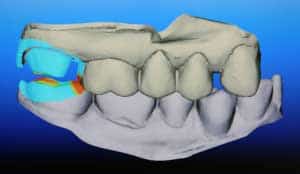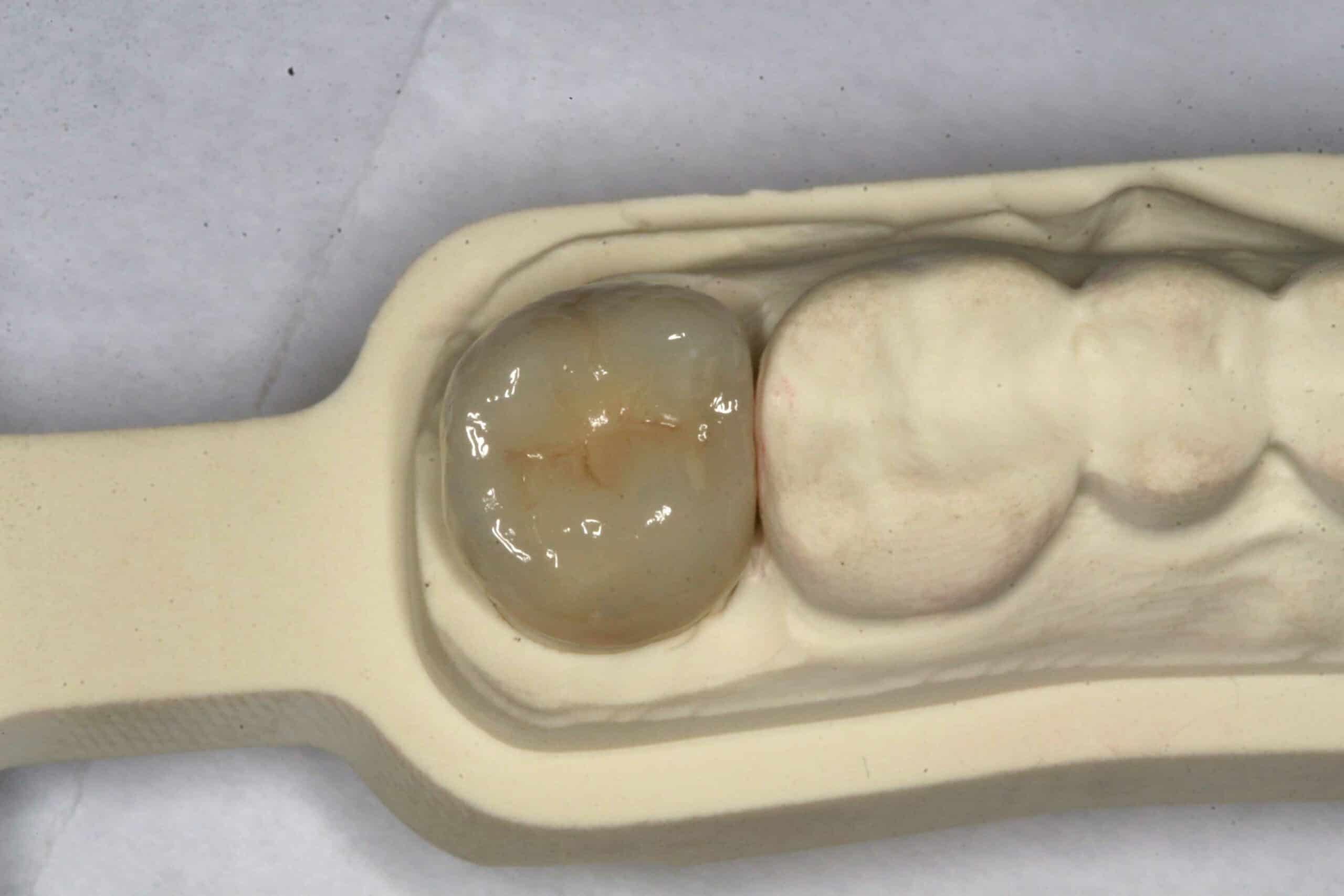Cape Dental Care has found another way to make our patients feel more comfortable at the dental office. As part of our office going green, we have implemented an intra-oral digital impression machine called the iTero. The technology is similar to the laser scanner they use at the supermarket, but this is in 3D! After we prepare your teeth for a crown, bridge or are manufacturing an implant supported tooth/teeth, we use a digital laser scanner inside your mouth to make digitally perfect impression of your mouth. This includes a digitally perfect bite as well.
 The old fashion way of making an impression for crowns, bridges and implants is to squirt your mouth full of sticky, gooey hydrocarbon impression material and then let it set for a few minutes so it can get hard enough to remove from the mouth in one piece. Then the dentist would inspect the impression and determine if it was “bubble free” and OK to use. If not, then you guessed it, another impression would have to be made. Dental impressions materials have a certain amount of error built into them as they set which will compound as you go through the crown/bridge manufacturing process. Not only is the hydrocarbon impression material/tray uncomfortable for the patient, but it is expensive and increases the carbon load for the environment. The impression would then have to be disinfected, packaged and mailed to a laboratory somewhere in the world. Some dentist actually send their impressions all the way to China, and the Philippines to get a less expensive product. These products from other countries are usually not of inferior grade, but just imagine what the carbon load is for mailing it there and back!
The old fashion way of making an impression for crowns, bridges and implants is to squirt your mouth full of sticky, gooey hydrocarbon impression material and then let it set for a few minutes so it can get hard enough to remove from the mouth in one piece. Then the dentist would inspect the impression and determine if it was “bubble free” and OK to use. If not, then you guessed it, another impression would have to be made. Dental impressions materials have a certain amount of error built into them as they set which will compound as you go through the crown/bridge manufacturing process. Not only is the hydrocarbon impression material/tray uncomfortable for the patient, but it is expensive and increases the carbon load for the environment. The impression would then have to be disinfected, packaged and mailed to a laboratory somewhere in the world. Some dentist actually send their impressions all the way to China, and the Philippines to get a less expensive product. These products from other countries are usually not of inferior grade, but just imagine what the carbon load is for mailing it there and back!
Next a dental lab technician will pour up the model in some kind of stone. When mixing, stone has to have very specific measurements, or it will not set accurately. Even the temperature, and humidity will effect its proper set. Most dental laboratories employ the lowest skilled worker to pour models and have no special precautions to assure the accuracy of their pour. In this way more errors are built into the manufacturing process. Some dental labs then pour an additional single stone model from the very same stretched out impression to help in the manufacturing process, thus adding even more error.
Most dental stone models used for manufacturing crown, and bridge are then “pin indexed”. This is the process of placing some type of pin into the underside of each tooth of interest on the model, so each tooth being manufactured can be cut free from the model for ease of making the crown/bridgework. Each separate tooth preparation is now called a dye. Each dye has to be trimmed by hand either by the dental technician, or by the dentist to make the margins of the prosthesis as accurate as possible. There is a very large chance for introducing errors during this step. If it is trimmed by the dentist it may or may not be more accurate, but it will have to be mailed back to the office once again increasing the mileage, and the carbon transportation load on the manufacturing process.
The models are usually accompanied by an opposing model so the teeth being manufactured can be made to bite against the opposing arches teeth. This has always been my problem with dental laboratories. They usually make a good looking crown that fits relatively good on the model, but when it goes into the mouth not only is it too tight against the adjacent teeth and the margins against the tooth are not usually perfect, but the occlusion (bite) is a mile off. Then I look at the expensive hydrocarbon bite I gave to them to set the teeth together with, and it has not even been used, and if they did used it, they never trimmed it properly to be useful in the first place. Error, error, error…
Now finally the skilled, trained, certified dental technician has to make a work-of-art on top of all of this accumulated error. It is a wonder why any crown/bridgework fits at all.
 Now enters the iTero digital impression machine into the dental profession. It looks like a large desktop computer with a mounted monitor. When it rolls into the room it immediately begins to impress the patient. Attached to the end of a long thick cable is what seems at first to be a rather large camera head, but the actual part that enters the mouth is surprisingly comfortable for the patient, and easy to manipulate by the dental staff. Once the name of the patient, the laboratory, type of crown/bridge, shades and possibly a written note to the dental technician is entered into the iTero machine, it is ready to perform its magic.
Now enters the iTero digital impression machine into the dental profession. It looks like a large desktop computer with a mounted monitor. When it rolls into the room it immediately begins to impress the patient. Attached to the end of a long thick cable is what seems at first to be a rather large camera head, but the actual part that enters the mouth is surprisingly comfortable for the patient, and easy to manipulate by the dental staff. Once the name of the patient, the laboratory, type of crown/bridge, shades and possibly a written note to the dental technician is entered into the iTero machine, it is ready to perform its magic.
When the teeth have been prepared, and are ready for an impression it is as simple as pushing a button, and the iTero asks for the first tooth to scan. After each scan a computer generated voice prompts the operator to scan
 the next tooth in the logical pattern of collecting data. After each preparation is scan and the appropriate amount of adjacent teeth are scanned, the opposing arch is also scanned. Once all the scans are finished, the iTero asks you to take a digital bite at certain teeth to maximized the accuracy of the bite. The doctor then examines the raw data on the computer monitor, and determines if all of the scans are complete. If an area of data is missing in the scans, or a preparation has to be modified, then it is as simple as taking another picture of the missing information, and letting the iTero software splice it into the pictures data. All of the scans can usually be made in the mouth, in the amount of time to took for the dental hydrocarbon impression material to set. And if there was time, a dental assistant could scan the opposing arch right after they entered all the patient data into the machine before the dentist ever arrived in the room for treatment. Easy!
the next tooth in the logical pattern of collecting data. After each preparation is scan and the appropriate amount of adjacent teeth are scanned, the opposing arch is also scanned. Once all the scans are finished, the iTero asks you to take a digital bite at certain teeth to maximized the accuracy of the bite. The doctor then examines the raw data on the computer monitor, and determines if all of the scans are complete. If an area of data is missing in the scans, or a preparation has to be modified, then it is as simple as taking another picture of the missing information, and letting the iTero software splice it into the pictures data. All of the scans can usually be made in the mouth, in the amount of time to took for the dental hydrocarbon impression material to set. And if there was time, a dental assistant could scan the opposing arch right after they entered all the patient data into the machine before the dentist ever arrived in the room for treatment. Easy!
 Now here is the real WOW factor for the patient: Once all the scans are complete I usually rotate the 3D model of their teeth for them to see, and then push the transmit button. I then tell them that all of this information is now on its way to Tel Aviv, over the internet. Sad to say some of my patient don’t know where that is, so I remind them that that is in Israel. After they manipulate the data in Tel Aviv and make it readable, they transmit the data to New Jersey where the models are mill out with a CAD/CAM computerized milling machine. Then they mail those models to Clearwater, Florida where they make the actual crown/bridge, and we then get it back in about two week. I also always remind them that this is a digitally perfect impression, and a digitally perfect bite. And that all of this process actually saves us money by not having to have all of the mailing and human craftsmanship. The carbon savings come from the saved materials and transportation.
Now here is the real WOW factor for the patient: Once all the scans are complete I usually rotate the 3D model of their teeth for them to see, and then push the transmit button. I then tell them that all of this information is now on its way to Tel Aviv, over the internet. Sad to say some of my patient don’t know where that is, so I remind them that that is in Israel. After they manipulate the data in Tel Aviv and make it readable, they transmit the data to New Jersey where the models are mill out with a CAD/CAM computerized milling machine. Then they mail those models to Clearwater, Florida where they make the actual crown/bridge, and we then get it back in about two week. I also always remind them that this is a digitally perfect impression, and a digitally perfect bite. And that all of this process actually saves us money by not having to have all of the mailing and human craftsmanship. The carbon savings come from the saved materials and transportation.
 The iTero digital impression is fast, accurate, and very accepted by the dental patient, and staff. And doesn’t need powder all over the teeth like those other machines. When the patient comes back for cementation and the crown/bridge is fitted without excessive adjustments, you will be really impressed! No more framework try-ins, or confirmation jigs. What you see is what you get.
The iTero digital impression is fast, accurate, and very accepted by the dental patient, and staff. And doesn’t need powder all over the teeth like those other machines. When the patient comes back for cementation and the crown/bridge is fitted without excessive adjustments, you will be really impressed! No more framework try-ins, or confirmation jigs. What you see is what you get.
